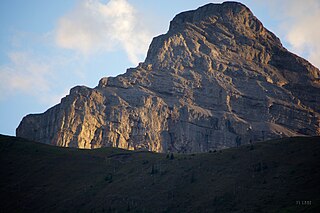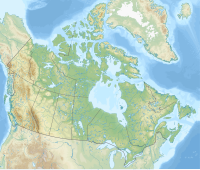
Mount Assiniboine, also known as Assiniboine Mountain, is a pyramidal peak mountain on the Great Divide, on the British Columbia/Alberta border in Canada.

Mount Columbia is a mountain located in the Winston Churchill Range of the Rocky Mountains. It is the highest point in Alberta, Canada, and is second only to Mount Robson for height and topographical prominence in the Canadian Rockies. It is located on the border between Alberta and British Columbia on the northern edge of the Columbia Icefield. Its highest point, however, lies within Jasper National Park in Alberta.

Mount Bryce is a mountain at the southwestern corner of the Columbia Icefield, in British Columbia, Canada, near the border with Alberta. It can be seen from the Icefields Parkway.

The Blue Range is a mountain range of the Canadian Rockies, located on the Continental Divide in Banff National Park, Canada. The range was so named on account of its blueish colour when viewed from afar. Mount Alcantara is the highest point in the range.

Mount Muir is a mountain located on the Continental Divide on the Alberta-British Columbia border. The mountain was named in 1918 after Alexander Muir. It is located in the High Rock Range.
Mount Ulysses, is the highest mountain in the Muskwa Ranges of the Northern Canadian Rockies in British Columbia. It and neighbouring peaks are part of a group of names drawing on the epic poem The Odyssey, in which here Ulysses wanders for 10 years before being able to return home to Ithaca.
Mount Chown is Alberta's 36th highest peak. It is named after the Reverend Samuel Dwight Chown. It is located in the northwest corner of Jasper National Park on the border with the Willmore Wilderness Park. It lies between the Chown and Resthaven Glaciers.
Mount Gorman is located on the border of Alberta and British Columbia. It was named in 1925 after A.O. Gorman, a government surveyor with the Dominion Land Survey.
Mount Côté is located on the border of Alberta and British Columbia. The mountain is named for Jean Côté, a Canadian politician.
Mount Leman is located on the border of Alberta and British Columbia. It was named in 1918 after Gérard Leman, a Belgian General who led the defensive forces in the Battle of Liège during World War I. He was captured by German forces and held as a prisoner of war until 1917.
Mount Queen Elizabeth is located on the border of Alberta and British Columbia, directly east of Mount King Albert. It was named in 1916 by interprovincial boundary surveyors after Queen Elisabeth of Belgium. Note that Elisabeth is the correct spelling of her name.

Mount Cautley is located on the border of Alberta and British Columbia on the Continental Divide, SE of Assiniboine Pass. Richard W. Cautley was a surveyor from Ipswich, England. As part of the Alberta/British Columbia Boundary Commission, his party was in charge of mapping precise boundaries in the usable mountain passes of the Canadian Rockies.
Mount Leval is located on the border of Alberta and British Columbia on the Continental Divide. It was named in 1918 after Gaston de Leval, a Belgian lawyer who unsuccessfully defended Edith Cavell, a British nurse. Cavell was caught helping Allied soldiers escape in German-occupied Belgium during World War I. She was tried for treason under German military law and executed by firing squad in 1915.
Mount King Albert is located on the border of Alberta and British Columbia on the Continental Divide at the North end of Height of the Rockies Provincial Park. It was named in 1918 after King Albert.

Mount Worthington is located on the eastern side of Mount McHarg, in Height of the Rockies Provincial Park, and straddles the Continental Divide marking the Alberta-British Columbia border. It was named in 1956 after Lt. Col. Don Worthington who was killed in action in 1944 during the Second World War while commanding the 7th Battalion, The British Columbia Regiment.
A mountain formerly known as Mount Pétain, but with no current official name, is located on the border of the Canadian provinces of Alberta and British Columbia (BC) on the Continental Divide.
Mount Bolton is located on the border of Alberta and British Columbia on the Continental Divide, northeast of Elkford, Kootenay Land District. It was named after Bolton, Lambert Ernest Stanley DLS. Bolton was serving with the Canadian Pioneers, 1st Battilion when he was killed in action on June 13, 1916.
Mount Etherington is located on the border of Alberta and British Columbia on the Continental Divide. It was named in 1918 after Colonel Frederick Etherington C.M.G.
Mount Holcroft is located on the border of Alberta and British Columbia on the Continental Divide. It was named after Herbert Spencer Holcroft (1877-1916), H.S. D.L.S. in 1918. Lieutenant Spencer was wounded during World War I and later died in hospital of cardiac failure.
Mount Lyall is located on the border of Alberta and British Columbia on the Continental Divide. It was named in 1917 after the Scottish botanist David Lyall (1817–1895).









